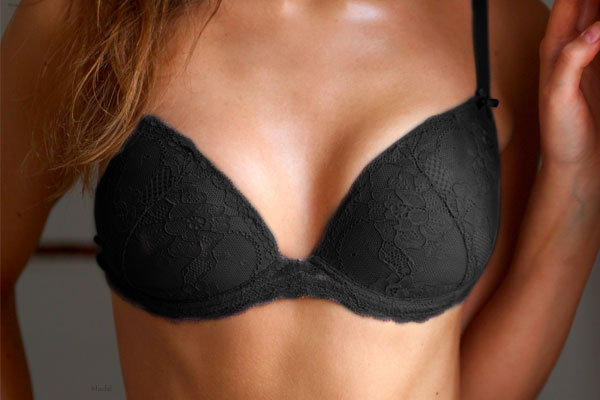Breast Augmentation in Dallas and Allen, TX
Model
Table of Contents
What Is Breast Augmentation Surgery?
Am I a Candidate for Breast Augmentation?
How Do I Choose the Right Plastic Surgeon?
Where Will My Breast Augmentation Incisions Be?
What Are My Breast Implant Options?
How Do I Pick the Right Breast Implant Size?
What Is the Breast Augmentation Procedure Like?
What Is Recovery Like After Breast Augmentation?
What Are the Risks of Breast Augmentation?
What Are the Results of Breast Augmentation?
Have More Questions?
What Is Breast Augmentation Surgery?
Breast augmentation, a cosmetic procedure to enlarge the female breasts, is one of the most popular and commonly performed cosmetic surgical procedures.
Breast augmentation accomplishes an enhancement of breasts to improve body proportions, breast symmetry, and a patient’s self-image and confidence.
This procedure is generally safe, with a high level of patient satisfaction. Women thinking about undergoing this procedure should carefully consider the various options and potential risks of the surgery.
Am I a Candidate for Breast Augmentation?
You may be the right candidate for breast augmentation if:
- You are unhappy with the size or shape of your breasts
- You have a deflated breast appearance due to breastfeeding and pregnancy
- You want fuller, more voluptuous curves
How Do I Choose the Right Plastic Surgeon?
One should select the plastic surgeon they trust and with whom they feel most comfortable. A surgeon’s credentials are also important, as it gives you an objective view into their training.
There are two important things to look for in a plastic surgeon:
- Board certification by the American Board of Plastic Surgery
- Hospital privileges to perform the procedure you are interested in, as hospitals do extensive vetting
The surgeon should explain the procedure, present options, and make recommendations based on your goals, their examination of your breasts, as well as their professional judgment and experience. It is important to understand that there is no standard breast augmentation technique.
The considerations for breast augmentation include:
- Incision location
- Implant type (saline or silicone)
- Location and size of surgical pocket (space) created in the breast tissue
- Postoperative care (activity, drains, compression, etc.)
- Size selection

Where Will My Breast Augmentation Incisions Be?
There are three standard breast augmentation incision options:
- Periareolar—around the lower half of the areola
- Inframammary—along the fold under the breast
- Transaxillary—within the armpit
Selection of an incision site is based on the patient’s preferences as well as the surgeon’s judgement.
The surgeon’s recommendation is based on implant type and size, risk considerations, and what they believe will allow them to technically achieve your goals.
Periareolar
The periareolar incision is created at the transition between the pigmented areolar skin (the darker skin surrounding the nipples) and the breast skin. It takes advantage of the color transition to conceal the scar.
This area scars very well and is often difficult to see once the scar has matured. There is no greater postoperative pain with the periareolar incision, nor is there a higher risk of nipple sensation loss. However, recent studies show a higher capsular contracture rate with this incision. It also may be more difficult to fit certain implants through this incision.
Inframammary
The inframammary incision is the most common incision used today. It is located in the fold under the breast.
It is most easily covered if the patient has a little droop in their breasts. This incision also goes through a minimum amount of breast tissue. For this reason, it has been shown to have the lowest capsular contracture incidence. It also allows for an adequately sized incision to be able to place all implant sizes and perform most technical adjuncts needed for some breast conditions.
Transaxillary
Transaxillary incisions are placed under the arm and are touted for not requiring any incisions on the breast.
However, there are many limitations as to what can be done through these incisions, and they are more difficult or not suitable for many technical variations or in the unlikely event that a secondary procedure is needed. It has also been shown to have a higher capsular contracture rate. Therefore, we rarely use this incision for breast augmentation in our Dallas practice.
What Are My Breast Implant Options?
Both saline and silicone breast implants are safe and can produce an excellent result. However, each type of implant has advantages and disadvantages that must be considered.
Silicone
The primary advantage of silicone is that it is more easily hidden visually and feels most similar to breast tissue. It is lighter (per volume) and has less effect on a breast that has poor support, usually making it a better choice for women after having children or for use with techniques that lift the breasts.
Silicone implants tend to have a longer lifespan. A disadvantage is that implant failure is typically only detectable through high-resolution ultrasound or MRI. The FDA recommends routine imaging of the implant for patients with silicone breast implants.
Saline
Saline breast implants are best for younger patients, those with dense breast tissue, and those with greater soft tissue coverage to hide the implant. Saline implants cost less and can be placed through a smaller incision, and implant ruptures or leaks are easily detected. However, saline implants are more palpable (easier to feel), can impart more stretch on inelastic breast tissue, and have a higher risk of visible wrinkling.
What Are Other Implant Considerations?
- Implant Style—Each manufacturer has various styles of implants that differentiate profile (e.g., high profile) based on the implant dimensions, implant shape, and whether it is textured or not.
- Texturing—Implants may have a smooth outer surface or a rough textured surface. Texturing was originally added to decrease the risk of capsular contracture. It is also added for shaped implants that need to maintain a specific orientation.
- Implant Shape—Implant shape is based on surgeon preference, specific anatomic needs of the patient, and risks (shaped implants have a risk of rotation that may distort the breast appearance).

How Do I Pick the Right Breast Implant Size?
This can be one of the most challenging parts of the procedure. We want to achieve your breast goals but also help you avoid potential complications or problems.
To achieve the best results, implant selection is based on a candid discussion of what you personally desire and your surgeon’s assessment of what may be most appropriate for your breast tissue characteristics.
Some of these problems include stretching of the lower portion of the breast, higher risk of palpability, visible wrinkles, and an unnatural appearance.
Our Process
The first step is a physical exam that measures critical dimensions of your breast and assesses the soft tissue characteristics. This analysis helps the surgeon determine a range of implant sizes and styles that are most appropriate for you. This is done at your initial consultation.
The next step is understanding your goals. At your pre-operative visit you will help Dr. Pollock to understand your goals through candid discussion, bringing in pictures that demonstrate your ideal outcome or any way you believe will help express your goals. From this discussion, Dr. Pollock will make a recommendation of the range of implant sizes that will meet your needs.
Finally, you will try on sizers to help you understand what that size looks like on you. Sizers placed in a bra and t-shirt are not a perfect representation of what you will look like but close enough to give you a good idea of how that size looks on you. It is important that you spend as much time as you need to be comfortable with your decision.
Important Notes on Implant Sizing
- Cup Size—This is a calculation based on your band size. While your cup size can be determined, manufacturers’ cup sizes are very inconsistent. There are variations by different manufacturers and by style. Therefore, your surgeon can never promise you a specific cup size.
- Implant Size—This is based on volume (in cubic centimeter of cc’s) and not on cup size. There is no “C cup implant.”
- Implants Do Not Equal a Breast Lift—An implant alone will not correct sagging. Contrary to what some believe (including some doctors), a large implant will not take the place of a breast lift and may worsen the appearance of the breast, making corrections difficult.
Where Are the Implants Placed?
The specifics of your surgery are individualized and based on your particular needs and goals. In general, through the planned incision, a pocket is created to hold the implant.
We most commonly create this pocket under the muscle (pectoralis major muscle), as this has been shown to decrease certain risks (contracture, rippling). Placement under the muscle also often looks more natural and tends to hold up better with time and aging. However, there are situations where we place the implant on top of the muscle. When placing the implants under the muscle, some of the lower muscle attachments must be cut to allow the implant to sit in the proper position. This does not affect the muscles strength.
What Is the Breast Augmentation Procedure Like?
Our goal is to provide cosmetically pleasing, long-term results with a natural appearance and feel, as well as a breast size that meets the patient’s expectations.
Where Is the Surgery Performed?
We provide surgical care in a variety of facilities, including major hospitals, outpatient surgery centers, and in our office-operating suite. Our office surgical suite is accredited by the American Association for the Accreditation of Ambulatory Surgical Facilities (AAAASF). Accreditation means that the facility has met strict safety standards.
In North Dallas, we use Texas Institute for Surgery, Presbyterian Hospital of Dallas, and our Office facility. In the Allen office, we use Methodist Craig Ranch and Presbyterian Hospital of Allen. Each facility has its own fee schedule.
Surgery locations and their fees will be discussed at your consultation.
What Type of Anesthesia Is Used?
Your choice of which anesthesia to use for your surgery is discussed during your consultation. Many factors are involved in this decision, including your general health, your preferences, surgery location, and other concerns.
The two most common types of anesthesia for breast augmentation are intravenous sedation (or twilight sleep) and general anesthesia. Breast augmentation is sometimes offered under local anesthesia alone. While this is possible and touted to be less expensive, we feel it is too uncomfortable for most patients and distracting to the surgeon, so we do not typically offer this.
Intravenous Sedation
Intravenous sedation delivers medications through an IV in conjunction with local anesthesia that puts the patient into a state of deep sleep.
This type provides a safe, effective anesthesia with a quicker recovery and less postoperative nausea and vomiting.
General Anesthesia
General anesthesia is a deep anesthetic where one is so deep in sleep that their breathing must be supported by a ventilator. It, too, is very safe and effective. General anesthesia has a reputation of longer recovery and postoperative nausea.
However, newer short-acting anesthetics make recovery and post-op nausea more close to that of sedation.
What Is Recovery Like After Breast Augmentation?
At the end of your procedure, the incision is closed with stitches under the skin. A light dressing and a surgical bra are placed. We do not use drains except under rare circumstances.
Breast augmentation is performed on an outpatient basis, and all postoperative instructions will be provided to you and your caregiver. It is necessary to have a responsible adult with you for the first 24 hours.
It is important that you are out of bed and moving around early after surgery, though there are some physical restrictions such as lifting and straining to avoid complications like bleeding.
You may experience swelling, bruising, and discomfort while you recover, but most patients can usually return to normal activities in a few days and vigorous exercise after three to four weeks.

What Are Risks of Breast Augmentation Surgery?
Complications can occur in any surgery and breast augmentation is no exception. Fortunately, complications in general are uncommon. But complication rates or re-operation rates reported in some articles can be difficult to interpret. For instance, as discussed below, all implants will ultimately fail and, therefore, removal or replacement risk is 100 percent. Implant revision rates may also seem high at first glance, but a closer look shows that the vast majority of these procedures are for elective change in size and not for a complication.
Certain complications are known to be associated with bacteria that live in breast tissue. We use antibiotics in your IV as well as a triple antibiotic irrigation of the surgical pocket. We also use a number of other proven techniques to minimize bacteria.
Below are some of the potential complications of breast augmentation surgery:
- Bleeding: While uncommon, bleeding in the implant pocket may occur, causing rapid breast swelling and discomfort. If this occurs, the patient may need to be returned to surgery, where the blood is washed out and bleeding is stopped. While this can be scary, it is easily dealt with and usually has no long-term consequences.
- Infection: This complication is very uncommon, as great measures are taken to eliminate bacteria during surgery. However, if it does occur, it is often necessary to remove the implant to clear the infections and then replace it once free of infection and inflammation.
- Permanent Loss of Nipple Sensation: Great efforts are made to avoid injury to the nerves that supply nipple sensation, and those efforts are typically very successful. But patients should know that there is a risk even in the best of hands. Temporary changes in nipple sensation (increased or decreased sensitivity) are more common and can last for a few days to a few months.
- Implant Deflation or Rupture: It is important to know that all implants will eventually fail and need to be replaced. When a saline implant fails, the saline (saltwater) leaks out and is absorbed by your body. This is usually very obvious. Slow leaks are possible but much less common. Silicone implant failure is not obvious, as the silicone stays in the scar pocket and there are no physical signs. Silicone implants require ongoing surveillance using high-resolution ultrasound or MRI. Mammograms may detect a failure but are unreliable. Silicone implants typically last longer than saline.
- Capsular Contracture: When a foreign object, like a breast implant, is placed in the body, the body walls it off with scar. Because breast implants are well-tolerated, the scar capsule surrounding the implant is usually thin and soft, allowing the breast to feel soft. In some cases, that scar can get thick and firm and make the breast firm and may even distort the breast shape. This is what is called capsular contracture. It is felt that it is most commonly associated with a bacteria that is present in the breast tissue. Use of specific cocktails of antibiotics and technical maneuvers can greatly reduce this contamination and greatly reduce the incidence of contracture. Degrees of contracture can vary from mild firmness to implant displacement, and treatment is based on that degree.
- Implant Associated Cancer: Recently, a cancer called anaplastic large cell lymphoma (ALCL) has been determined to be associated with breast implants. This cancer is very rare and to date has only been associated with textured breast implants. More than 80 percent of cases have been associated with one type of texturing (Allergan Biocell), and they have now been removed from the market. It presents many years after the implant has been placed and most commonly presents as breast swelling that is actually a fluid collection. In most cases, this cancer is easily treated by just removing the scar capsule and implant. While it is important to be informed, patients should understand the rarity and absence of cases with smooth surfaced implants.
- Implant Associated Illness: Also known as Breast Implant Illness or BII. There are women who have breast implants and also have a wide and varied range of common symptoms (such as joint pain, fatigue, headaches, rashes, etc.) who believe these symptoms are due to their breast implants. As these symptoms are so varied and common to those who don’t have breast implants, it has not been possible to date to scientifically identify a link. The plastic surgery community accepts that there may be an association to breast implants, and there are a number of ongoing studies to look into it. However, the internet and social media have been an avenue for propagation of misinformation leading to unnecessary fear. This is something that should be discussed with your surgeon to sort facts from opinion.
What Are the Results After Breast Augmentation?
Post-surgical changes such as swelling and bruising take time to resolve. However, in most patients, these changes resolve fairly quickly; by a week or two, the appearance and size are close to how your breasts ultimately look.
More subtle changes can occur over several months. One should realize that breasts change in appearance over a woman’s lifetime and are most affected by pregnancy, weight changes, and menopause.
Where Are the Before and After Pictures?
For a number of reasons, we have resisted the marketing pressure to feature a gallery of before and after pictures on our website. While we are very proud of our results, we feel that the benefit of reviewing before and after pictures is best when looked at with a surgeon who has examined you and can put the pictures into perspective as they relate to you. For instance, one may see a picture where the space between the breast seems excessive and be turned off. The surgeon who has examined you will be able to point out that it was a pre-existing feature of that patient and that you are or are not at risk for that. In our consultations, Dr. Pollock (not an assistant) reviews before and after pictures with potential patients. This can alleviate unnecessary fears or point out issues that will give more realistic expectations.
We are happy to show the quality of our results to prospective patients. The intent of showing photos is to educate patients and illustrate key points about the procedure and the results as they relate to you. We do, in fact, also show potential patients less than ideal results to represent particular issues and risks and help our patients maintain realistic expectations.

Have More Questions About Breast Augmentation?
Dr. Pollock performs breast augmentation in Dallas and Allen, and patients come from many nearby areas, including Plano, Richardson, and McKinney as well as the larger Dallas-Fort Worth-Arlington metropolitan area.
If you want to learn more about breast augmentation, call our office at (214) 363-2575 or fill out our online form.
Financing Information
We are committed to helping you attain your cosmetic goals and are happy to work with you to find a payment method or plan that fits your situation. We offer financing through CareCredit, which provides flexible repayment options.
Financing Available
Contact Form
Our Locations
Contact information for individual North Dallas Plastic Surgery offices
North Dallas Office
8305 Walnut Hill Ln #210
Dallas, TX 75231
Phone: (214) 363-2575
Directions & Office HoursAllen, Tx Office
317 N. Central Expressway Suite 100
Allen, Texas 75013
Phone: (214) 509-0270
Directions & Office Hours